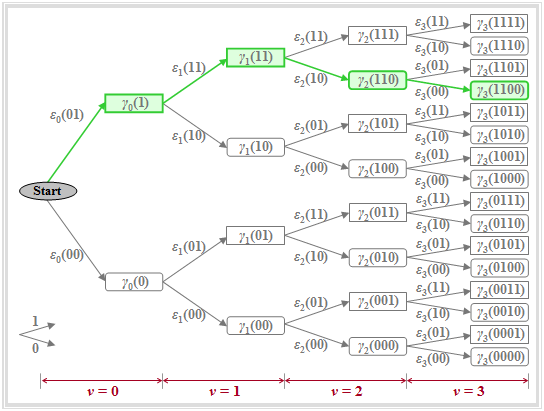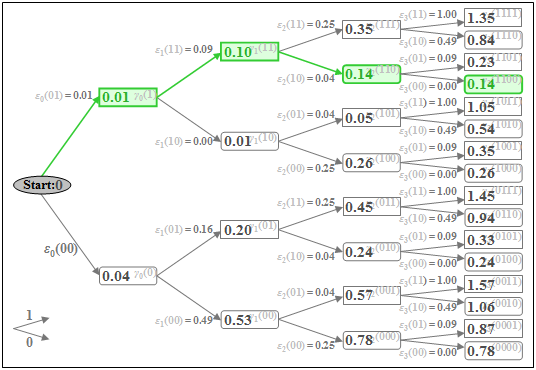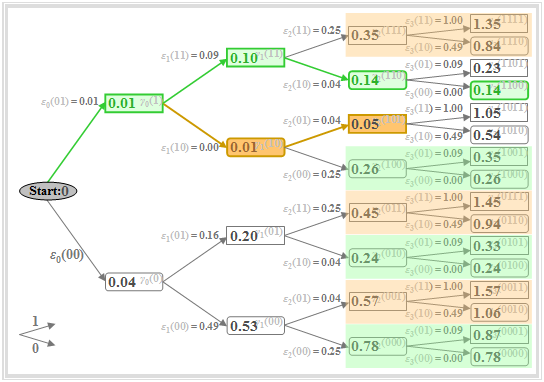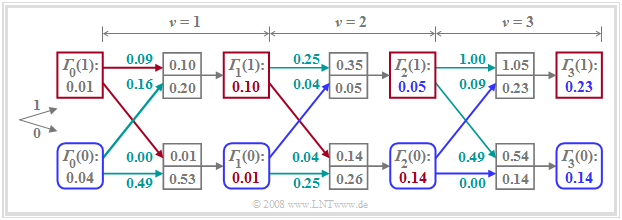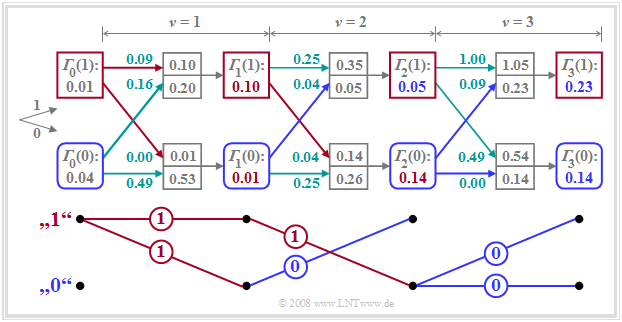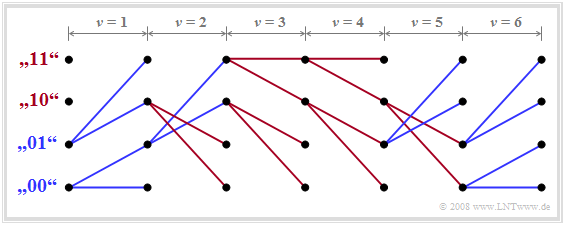Contents
- 1 Considered scenario and prerequisites
- 2 Error quantities and total error quantities
- 3 Minimum total error quantities
- 4 Representation of the minimum total error quantities – Trellis diagram
- 5 Simplified trellis diagram
- 6 Erweiterung auf zwei Vorläufer
- 7 Error probability in maximum likelihood decision
- 8 Aufgaben zum Kapitel
Considered scenario and prerequisites
The "correlation receiver" is optimal in the sense of the "maximum likelihood decision rule", that is, it leads to the minimum error probability for equally likely source symbols. Disadvantage:
- The realization cost increases exponentially with the length $N$ of the symbol sequence to be detected.
- Since the sequence is decided jointly, long delays occur when $N$ is large.
In the 1970s, "Andrew J. Viterbi" proposed a maximum likelihood receiver that allows detection of parts of the received message and for which the implementation cost is limited even for infinitely long sequences.
It should be noted with regard to the individual components of the block diagram:
- Adjusted to the basic reception pulse $g_r(t)$ and the noise, the "matched filter" $H_{\rm MF}(f)$ serves for noise power limitation. The MF output signal $m(t)$ or the sequence $\langle m_\nu \rangle$ of equidistant signal values after sampling has the best possible signal-to-noise power ratio.
- The task of the decorrelation filter $H_{\rm DF}(f)$ is to extract from the sequence $\langle m_\nu \rangle$ the detection samples $d_\nu = d_{{\rm S}\nu} + d_{{\rm N}\nu}$ whose noise components $d_{{\rm N}\nu}$ are uncorrelated. This filter is therefore also called a whitening filter.
- The Viterbi decision, which is the focus of the following considerations, obtains the binary output sequence $\langle v_\nu \rangle$ ; from the sequence $\langle d_\nu \rangle$  of its continuous value input values according to the maximum likelihood rule with the smallest possible error probability ${\rm Pr}(v_\nu \ne q_\nu)$.
In order to describe the Viterbi algorithm as simply as possible, some simplifying assumptions are made here:
- Let the amplitude coefficients be unipolar ⇒ $a_\nu \in \{0,\hspace{0.05cm} 1\}$. Note that using bipolar coefficients ⇒ $a_\nu \in \{-1,\hspace{0.05cm} +1\}$ requires only a few modifications. These difficulties concern the description rather than the implementation.
- The basic pulse $g_d(t)$ consists only of the main value $g_0 = g_d(t = T_{\rm D})$ and a single precursor $g_{-1} = g_d(t = T_{\rm D}-T)$.
- This gives $d_{\nu} = a_{\nu}\cdot g_{0} + a_{\nu+1}\cdot g_{-1}+d_{{\rm N}\nu}\hspace{0.05cm}$ for the continuous-value detection samples, where the noise component $d_{{\rm N}\nu}$ is assumed to be Gaussian distributed with standard deviation $\sigma_d$.
Note: With bipolar signaling, the algorithm is not more complex. In contrast, the computational cost increases when the basic detection pulse becomes broader and has more than one precursor $g_{-1}$. The neglect of precursors in the description is not a fundamental limitation because any pulse $g_d(t)$ can satisfy this condition by appropriate choice of the detection time $T_{\rm D}$. It should be further noted that in the following all signal values are normalized to $1$.
$\text{Example 1:}$ In the graph, the detection useful samples $d_{ {\rm S}\nu}$ are entered as (blue) crosses, where the corresponding amplitude coefficients $a_1 = 1$, $a_2 = 1$, $a_3 = 0$, ... can be read from the source signal $q(t)$ plotted in green.
The basic pulse values in this example are assumed to be $g_0 = 0.7$ and $g_{-1} = 0.3$. It can be further seen that $d_{ {\rm S}\nu}$ can take only four different values, namely $0$, $g_{-1}=0.3$, $g_0= 0.7$ and $g_0 +g_{-1}= 1$.
The samples present at the Viterbi decision (red dots) are $d_0 = 0.2$, $d_1 = 0.7$, $d_2 = 0.5$, $d_3 = 0$, ... , where the differences $d_{ {\rm N}\nu} = d_\nu - d_{ {\rm S}\nu}$ originate from an AWGN noise source.
- A threshold decision $($with the threshold at $E = 0.5)$ would make at least one wrong decision at these ten bits shown $($at time $t = 4T)$, and possibly another at $t = 2T$ if the sample $d_2 = 0.5$ is nevertheless slightly smaller than the threshold $E = 0.5$.
- In contrast, the Viterbi receiver will correctly decide this sequence of length $10$, as shown in the next sections.
Error quantities and total error quantities
As in the chapter "Optimal Receiver Strategies", $Q \in \{Q_i\}$ specifies the bounded source symbol sequence consisting of $N$ binary symbols.
- Thus, the number of possible symbol sequences $Q_i$ is $2^N$.
- $V$ denotes the sink symbol sequence of length $N$ set equal to the most probable sequence $Q_j$ by the Viterbi decision.
$\text{Definition:}$ The error quantity $\varepsilon_{\nu}(i)$ denotes the squared deviation between the actual, noisy sample $d_\nu$ and the useful sample $d_{ {\rm S}\nu}$ belonging to the sequence $Q_i$:
- $$\varepsilon_{\nu}(i) = \vert d_{\nu} - d_{ {\rm S}\nu}(i) \vert^2 \hspace{0.05cm}.$$
In the literature, this is also referred to as "metric".
$\text{Definition:}$ The total error quantity $\gamma_{\nu}(i)$ characterizes the sum of all error quantities up to time $\nu$:
- $$\gamma_{\nu}(i)= \sum_{k=0}^{\nu}\varepsilon_{k}(i) \hspace{0.05cm}.$$
In this context, one also speaks of the "accumulated metric".
The graph illustrates the quantities defined above in a tree structure, from which it can be seen that the total error quantities can be calculated iteratively:
- $$\gamma_{\nu}(i)= \gamma_{\nu-1}(i\hspace{0.05cm}')+\varepsilon_{\nu}(i\hspace{0.05cm}'') \hspace{0.05cm}.$$
Notes:
- $i$, $i\hspace{0.05cm}'$, $i\hspace{0.05cm}''$ are different index variables.
- The above definition is valid for a basic pulse with main value $g_{0}$ and a precursor $g_{-1}$.
- With $v$ precursors the above sum would have to start at $k = 1 -v$.
- The parameter $i \in \{0, \hspace{0.05cm}\text{...} \hspace{0.05cm}, 2^{N+1}-1\}$ is usually represented in binary and thus describes the amplitude coefficients $a_1$, ... , $a_{\nu +1}$ $($each $0$ or $1)$.
Further, it should be noted about this graph:
- The nodes of the tree diagram represent the total error quantities $\gamma_{\nu}(i)$. Their number is doubled with each iteration step. At time $\nu$, there are $2^{\nu+1}$ such nodes. For example, for $\nu = 3$, exactly $2^4 = 16$ nodes can be seen.
- The amplitude coefficients associated with the total error quantities $\gamma_{\nu}(i)$ are obtained by following the path from the initial node to the node under consideration. It is agreed that an upward branch is assigned the coefficient $a_\nu=1$ and a downward branch is assigned the coefficient $a_\nu=0$.
- For example, the green highlighted node $\gamma_{3}(\rm 1100)$ denotes the total error quantity under the hypothetical assumption that the symbols $a_1=1$, $a_2=1$, $a_3=0$, $a_4=0$ were sent. This assignment can also be read from the directions of the arrows in the tree diagram: First twice upwards, then twice downwards.
- Due to the precursor, the coefficient $a_4$ must already be taken into account at time $\nu = 3$. All nodes $\gamma_{\nu}(i)$ computed under the assumption $a_{\nu +1}=1$ are represented by rectangles in the tree diagram, while the hypothesis $a_{\nu +1}=0$ is symbolized by a rounded rectangle in each case, for example $\gamma_{2}(\rm 110)$ or $\gamma_{3}(\rm 1100)$.
- The branches in the tree diagram are assigned to the error quantities $\varepsilon_{\nu}(i)$. With the assumed basic pulse (only $g_{0}$ and $g_{-1}$ are nonzero), there are exactly four different quantities at each time point except for the initial state $(\nu = 0)$:
- $$\varepsilon_{\nu}(00) = |d_{\nu}|^2\hspace{0.05cm},\hspace{0.5cm}\varepsilon_{\nu}(01) = |d_{\nu}-g_{-1}|^2\hspace{0.05cm},\hspace{0.2cm} \varepsilon_{\nu}(10) = |d_{\nu}-g_{0}|^2\hspace{0.05cm},\hspace{0.2cm}\varepsilon_{\nu}(11) = |d_{\nu}-g_{0}-g_{-1}|^2\hspace{0.05cm}.$$
- The total error quantity $\gamma_{\nu}(i)$ is equal to the sum of the preceding node $\gamma_{\nu-1}(i\hspace{0.05cm}')$ and the intervening branch $\varepsilon_{\nu}(i\hspace{0.05cm}'')$. For example, for the highlighted nodes:
- $$\gamma_{1}(11)=\gamma_{0}(1)+\varepsilon_{1}(11) ,\hspace{0.25cm} \gamma_{2}(110)=\gamma_{1}(11)+\varepsilon_{2}(10) ,\hspace{0.25cm} \gamma_{3}(1100)=\gamma_{2}(110)+\varepsilon_{3}(00).$$
- For the first nodes $\gamma_{0}(0)$ and $\gamma_{0}(1)$, it is considered that, by convention, the symbol $(a_1$, $a_2$, ...$)$ is always transmitted before the actual transmission $a_0 = 0$. It follows that:
- $$\gamma_{0}(0)=\varepsilon_{0}(00)= |d_{0}|^2 \hspace{0.05cm},\hspace{0.2cm} \gamma_{0}(1)=\varepsilon_{0}(01)=|d_{0}-g_{-1}|^2 \hspace{0.05cm}.$$
The following two examples will hopefully clarify these somewhat tedious statements.
$\text{Example 2:}$ As in $\text{Example 1}$, we consider the unipolar source symbol sequence of length $N=3$ with the following parameter values:
- $$g_{0}=0.7 \hspace{0.05cm},\hspace{0.2cm} g_{-1}=0.3 \hspace{0.05cm},\hspace{0.2cm} d_{0}=0.2 \hspace{0.05cm},\hspace{0.2cm} d_{1}=0.7 \hspace{0.05cm},\hspace{0.2cm} d_{2}=0.5 \hspace{0.05cm},\hspace{0.2cm} d_{3}=0 \hspace{0.05cm} \hspace{0.05cm}.$$
Then, for the error quantities $\varepsilon_{\nu}(i)$ at time points $\nu = 0$ to $\nu = 3$:
- $$\nu = 0\text{:} \hspace{0.2cm}\varepsilon_{0}(00) = \big [0.2- (0 \cdot 0.7 + 0 \cdot 0.3) \big ]^2=0.04 \hspace{0.05cm},\hspace{0.4cm} \varepsilon_{0}(01) = \big [0.2- (0 \cdot 0.7 + 1 \cdot 0.3) \big ]^2=0.01 \hspace{0.05cm};$$
- $$\nu = 1{:} \hspace{0.2cm}\varepsilon_{1}(00) = \big [0.7- (0 \cdot 0.7 + 0 \cdot 0.3)\big ]^2=0.49 \hspace{0.05cm},\hspace{0.4cm} \varepsilon_{1}(01) = \big [0.7- (0 \cdot 0.7 + 1 \cdot 0.3)\big ]^2=0.16 \hspace{0.05cm},$$
- $$\hspace{1.4cm}\varepsilon_{1}(10) = \big [0.7- (1 \cdot 0.7 + 0 \cdot 0.3)\big ]^2=0.00 \hspace{0.05cm}\hspace{0.4cm}\varepsilon_{1}(11) = \big [0.7- (1 \cdot 0.7 + 1 \cdot 0.3)\big ]^2=0.09 \hspace{0.05cm};$$
- $$\nu = 2\text{:} \hspace{0.2cm}\varepsilon_{2}(00) = \big [0.5- (0 \cdot 0.7 + 0 \cdot 0.3)\big ]^2=0.25 \hspace{0.05cm},\hspace{0.4cm}\varepsilon_{2}(01) = \big [0.5- (0 \cdot 0.7 + 1 \cdot 0.3)\big ]^2=0.04 \hspace{0.05cm},$$
- $$\hspace{1.4cm}\varepsilon_{2}(10) = \big [0.5- (1 \cdot 0.7 + 0 \cdot 0.3)\big ]^2=0.04 \hspace{0.05cm},\hspace{0.4cm}\varepsilon_{2}(11) = \big [0.5- (1 \cdot 0.7 + 1 \cdot 0.3)\big ]^2=0.25 \hspace{0.05cm};$$
- $$ \nu = 3\text{:} \hspace{0.2cm}\varepsilon_{3}(00) = \big [0.0- (0 \cdot 0.7 + 0 \cdot 0.3)\big ]^2=0.00 \hspace{0.05cm},\hspace{0.4cm}\varepsilon_{3}(01) = \big [0.0- (0 \cdot 0.7 + 1 \cdot 0.3)\big ]^2=0.09 \hspace{0.05cm},$$
- $$\hspace{1.4cm}\varepsilon_{3}(10) = \big [0.0- (1 \cdot 0.7 + 0 \cdot 0.3)\big ]^2=0.49 \hspace{0.05cm},\hspace{0.4cm}\varepsilon_{3}(11) = \big [0.0- (1 \cdot 0.7 + 1 \cdot 0.3)\big ]^2=1.00 \hspace{0.05cm}.$$
$\text{Example 3:}$ With the error quantities $\varepsilon_{\nu}(i)$ determined in $\text{Example 2}$, the total error quantities $\gamma_{\nu}(i)$ can now also be calculated. Below is the tree diagram with the total error quantities $\gamma_{\nu}(i)$ as nodes for the time points $\nu = 0$ to $\nu = 3$.
The minimum total error quantity at time $\nu = 3$ is $\gamma_{3}(\rm 1100) = 0.14$. From this, the coefficients of the most likely transmitted (unipolar) sequence according to the present signal values $d_0 = 0.2$, $d_1 = 0.7$, $d_2 = 0.5$ and $d_3 = 0$ are $a_1 = 1$, $a_2 = 1$ and $a_3 = 0$ (green path).
Further, it should be noted:
- If the sequence length is $N = 3$ (that is: only three symbols are jointly decided by the Viterbi receiver), the decision $a_4 = 0$ is also certainly the correct one, since all coefficients $a_{\nu>3}$ were assumed to be zero.
- However, for longer sequences $(N > 3)$, it cannot necessarily be concluded from the minimum value $\gamma_{3}(\rm 1100)$ that $a_1 = 1$, $a_2 = 1$, $a_3 = 0$ is actually part of the most probable sequence. Considering further sample values $(d_4$, $d_5$, ...$)$ this preliminary result could well change.
Minimum total error quantities
We continue from the numerical values of the last examples:
- $$d_{0}=0.2 ,\hspace{0.1cm} d_{1}=0.7 ,\hspace{0.1cm} d_{2}=0.5 ,\hspace{0.1cm} d_{3}=0 ,$$
- $$g_{0}=0.7 ,\hspace{0.1cm} g_{-1}=0.3 .$$
Thus, nothing changes in the tree diagram compared to $\text{Example 3}$. Some colored markings in this diagram only indicate in which way the tree diagram can be simplified according to Viterbi's suggestions.
Important properties of the Viterbi decision can be seen in the above graph, for example, at time $\nu = 2$:
- At time $\nu = 2$, the minimum total error quantity is $\gamma_{2}(\rm 101) = 0.05$ (highlighted in brown). This means: A decision at $\nu = 2$ – based on $d_0$, $d_1$ and $d_2$ – would have been in favor of sequence $\rm 101$ instead of the transmitted sequence $\rm 110$.
- It follows: A too early final determination should be avoided at all costs. However, at any time $\nu$ one can already exclude several partial symbol sequences which need not be considered at later times.
- To $\gamma_{2}(\rm 111) = 0.35$ the same error quantities $\varepsilon_{3}(\rm 11)$ and $\varepsilon_{3}(\rm 10)$ are added as to $\gamma_{2}(\rm 101) = 0.05$. Because of $\gamma_{2}(\rm 111) > \gamma_{2}(\rm 101)$ it is therefore already certain at $\nu = 2$ that $\rm 111$ cannot be part of the most probable sequence. The same is true for $\rm 001$ and $\rm 011$. Therefore, these nodes and all their successors need not be considered further (brown overlaps).
- Also, the rounded nodes $\gamma_{2}(\rm 000) = 0.78$, $\gamma_{2}(\rm 010) = 0.24$ and $\gamma_{2}(\rm 100) = 0.26$ are not part of the most probable sequence, since they are larger than the node $\gamma_{2}(\rm 110) = 0.14$, which is marked in green. Also, these and their successors need not be considered from time $\nu = 3$ (green covers).
$\text{Conclusion:}$
- Of the eight nodes at $\nu = 2$, only two need to be followed up, namely the rectangle $\gamma_{2}(\rm 101) = 0.05$ and the rounded rectangle $\gamma_{2}(\rm 110) = 0.14$.
- These describe the minimum total error quantities assuming that $a_3 = 0$ and $a_3 = 1$, respectively.
Representation of the minimum total error quantities – Trellis diagram
We now generalize the result of this example. Under the still valid assumption that the basic pulse has only one precursor $(g_{-1})$ besides the main value $(g_0)$, the two minimum total error quantities at time $\nu$ are formally given by
- $${\it \Gamma}_{\nu}(0) = {\rm Min}\left[{\it \Gamma}_{\nu-1}(0) + \varepsilon_{\nu}(00), \hspace{0.2cm}{\it \Gamma}_{\nu-1}(1) + \varepsilon_{\nu}(10)\right] \hspace{0.05cm},$$
- $${\it \Gamma}_{\nu}(1) = {\rm Min}\left[{\it \Gamma}_{\nu-1}(0) + \varepsilon_{\nu}(01), \hspace{0.2cm}{\it \Gamma}_{\nu-1}(1) + \varepsilon_{\nu}(11)\right] \hspace{0.05cm}.$$
The total error minimization procedure can be clearly illustrated in the trellis diagram.
A comparison with the figures in the last sections shows:
- The lower branch represents the minimum total error quantity ${\it \Gamma}_{\nu}(0)$ calculated at each time $\nu$ under the hypothesis that $a_{\nu + 1} = 0$ will hold (blue rounded squares).
- In contrast, the upper branch describes the minimum total error quantities ${\it \Gamma}_{\nu}(1)$ under the assumption $a_{\nu + 1} = 1$ (red squares). Again, the numerical values are adapted to the previous example.
- Besides ${\it \Gamma}_{\nu}(0)$ and ${\it \Gamma}_{\nu}(1)$, the maximum likelihood decision must also store the associated symbol sequences (paths). These branches are highlighted in red and blue, respectively, in the graph.
- If ${\it \Gamma}_{\nu}$ arises from the node ${\it \Gamma}_{\nu-1}(0)$ – that is, if the lower of the two incoming branches is highlighted – the associated symbol is $\rm 0$, otherwise the symbol is $\rm 1$.
- At time $\nu = 3$, for example, both ${\it \Gamma}_{3}(0) = 0.14$ and ${\it \Gamma}_{3}(1) = 0.23$ result from the precursor ${\it \Gamma}_{2}(0)$, so that both selected paths point to the symbol $\rm 0$, respectively (blue branches).
Simplified trellis diagram
The advantage of the trellis diagram is that the number of nodes and branches does not double at each iteration step. By selecting the minimum total error quantities, only those symbol sequences are considered further which can be considered as part of the most probable sequence at all.
The trellis diagram can be further simplified by drawing in only the selected branches. This is illustrated in the lower part of the diagram with our numerical example. As a reminder: The actual transmitted amplitude coefficients are $a_1= 1$, $a_2= 1$ and $a_3= 0$, and the trellis diagram drawn above was calculated assuming that due to the pulse values $g_{-1} = 0.3$ and $g_{0} = 0.7$ as well as the AWGN noise, the input values $d_0= 0.2$, $d_1= 0.7$, $d_2= 0.5$ and $d_3= 0$ are applied to the ML decision.
This simplified trellis diagram allows the following statements:
- Die Entscheidung über $a_1= 1$ kann sofort zum Zeitpunkt $\nu = 1$ getroffen werden, da sich unter beiden Hypothesen – nämlich das nachfolgende Symbol sei $a_2= 0$ bzw. dieses Symbol sei $a_2= 1$ – das gleiche Resultat $a_1= 1$ ergibt.
- Dagegen kann zum Zeitpunkt $\nu = 2$ die endgültige Entscheidung über $a_2$ noch nicht getroffen werden. Unter der Annahme, dass $a_3= 0$ sein wird, müsste man sich für $a_2= 1$ entscheiden, während die Hypothese $a_3= 1$ zur Festlegung auf $a_2= 0$ führen würde.
- Zur Zeit $\nu = 3$ ist die Entscheidung für $a_1= 1$, $a_2= 1$, $a_3= 0$ endgültig, da beide durchgehenden Pfade diese (die in diesem Fall richtige) Folge suggerieren.
- Würde man die Entscheidung auf den Zeitpunkt $\nu = 4$ verschieben, so hätte man nicht mehr nutzbare Information über $a_1$, $a_2$ und $a_3$ zur Verfügung.
Alle Aussagen dieses Kapitels können mit dem interaktiven Applet Viterbi–Empfänger für einen Vorläufer verifiziert werden.
Erweiterung auf zwei Vorläufer
Wird der Grundimpuls durch die Abtastwerte $g_{0} \ne 0$, $g_{-1} \ne 0$ und $g_{-2} \ne 0$ beschrieben, so müssen im Trellisdiagramm zu jedem Zeitpunkt $\nu$ vier Metriken ${\it \Gamma}_{\nu}(00)$, ${\it \Gamma}_{\nu}(01)$, ${\it \Gamma}_{\nu}(10)$ und ${\it \Gamma}_{\nu}(11)$ bestimmt werden. ${\it \Gamma}_{\nu}(01)$ beschreibt dann beispielsweise die minimale Gesamtfehlergröße für die Detektion des Symbols $a_\nu$ unter der Hypothese, dass $a_{\nu-1} = 0$ und $a_{\nu-2} = 1$ sein werden, und es gilt:
- $${\it \Gamma}_{\nu}(01) = {\rm Min}\big[{\it \Gamma}_{\nu-1}(00) + \varepsilon_{\nu}(001), \hspace{0.2cm}{\it \Gamma}_{\nu-1}(10) + \varepsilon_{\nu}(101)\big] \hspace{0.05cm}.$$
In der Aufgabe 3.12 wird im Detail auf die Berechnung der Fehlergrößen (Metriken) und die Minimierung der Gesamtfehlergrößen (akkumulierten Metriken) eingegangen.
$\text{Beispiel 4:}$ Wir betrachten hier ein beispielhaftes Trellisdiagramm, das die (fehlerfreie) Detektion von folgender Symbolfolge widergibt:
- $$a_{1}=0 \hspace{0.05cm},\hspace{0.2cm} a_{2}=0 \hspace{0.05cm},\hspace{0.2cm} a_{3}=1 \hspace{0.05cm},\hspace{0.2cm} a_{4}=1 \hspace{0.05cm},\hspace{0.2cm} a_{5}=1 \hspace{0.05cm},\hspace{0.2cm} a_{6}=0 \hspace{0.05cm}, \hspace{0.05cm}\text{...}$$
Dieses vereinfachte Trellisdiagramm erlaubt folgende Aussagen:
- Alle von ${\it \Gamma}_{\nu}(00)$ bzw. ${\it \Gamma}_{\nu}(01)$ abgehende Zweige sind dem Symbol $\rm 0$ zugeordnet und blau gezeichnet. Die von den beiden oberen Zuständen abgehenden roten Zweige kennzeichnen das Symbol $\rm 1$.
- Verfolgt man die durchgehenden Pfade, so erkennt man die angegebene Folge. Da zum Zeitpunkt $\nu = 6$ nur blaue Zweige ankommen, liegen hier die ersten sechs Bit der Folge endgültig fest.
- Teilfolgen könnten aber auch bereits zu den Zeiten $\nu = 1$, $\nu = 3$ und $\nu = 4$ ausgegeben werden, da sich zu diesen Zeiten für alle vier Zustände die gleichen Teilpfade ergeben.
- Dagegen darf bei $\nu = 2$ und $\nu = 5$ nicht sofort entschieden werden. Beispielsweise ist zum Zeitpunkt $\nu = 5$ nur sicher, dass entweder $a_5 = 0$ und $a_6 = 1$ sein werden oder $a_5 = 1$ und $a_6 = 0$. Andere Kombinationen sind nicht möglich.
Error probability in maximum likelihood decision
Die exakte Fehlerwahrscheinlichkeitsberechnung bei ML–Entscheidung (zum Beispiel mit dem Korrelations– oder dem Viterbi–Empfänger) ist sehr aufwändig. Dabei müssen
- die Differenzenergien zwischen allen möglichen Symbolfolgen $Q_i$ und $Q_{j \ne i}$ ermittelt werden, wobei die Fehlerwahrscheinlichkeit im Wesentlichen durch die minimale Differenzenergie bestimmt wird;
- auch die Einflüsse von Matched–Filter $H_{\rm MF}(f)$ und Dekorrelationsfilter $H_{\rm DF}(f)$ berücksichtigt und zusätzlich der Effektivwert $\sigma_d$ des Detektionsstörsignals bestimmt werden.
$\text{Ohne Beweis:}$ Eine einfache Näherung für die (mittlere) Fehlerwahrscheinlichkeit bei Maximum–Likelihood––Entscheidung lautet:
- $$p_{\rm ML} = {\rm Q}\left(g_{\rm max}/{\sigma_d}\right) \hspace{0.3cm}{\rm mit}\hspace{0.2cm}g_{\rm max}= {\rm Max}\hspace{0.15cm} \vert g_\nu \vert \hspace{0.05cm}.$$
Die Näherung gilt nur für binäre bipolare Signalisierung. Bei unipolarer Signalisierung ist das Argument der Q-Funktion zu halbieren.
Für die folgende Interpretation und das anschließende Beispiel wird vorausgesetzt, dass $v + 1$ Grundimpulswerte (inklusive Hauptwert) von Null verschieden sind. Dann gilt:
- Der Viterbi–Entscheider muss alle diese Grundimpulswerte berücksichtigen. Das bedeutet, dass ein Trellisdiagramm mit $2^v$ Zuständen zu bearbeiten ist.
- Voraussetzung für die Gültigkeit obiger Gleichung ist die Unkorreliertheit der Störungen am Entscheider, die durch das Dekorrelationsfilter erreicht wird.
- Für den Vergleich mit Schwellenwertentscheider $(p_{\rm SE})$ bzw. Entscheidungsrückkopplung $(p_{\rm DFE})$ wird der Störeffektivwert $\sigma_d$ als konstant vorausgesetzt.
- Die Optimierung des ML–Systems führt zu sehr schmalbandigen Filtern, da alle Impulsausläufer durch den ML–Algorithmus herausgerechnet werden können.
- Bei konstanter Rauschleistungsdichte $N_0$ (am Empfängereingang) ist somit der Störeffektivwert $\sigma_d$ (am Entscheider) beim ML–System kleiner als bei anderen Varianten.
- Das bedeutet: Der Störabstandsgewinn durch die ML–Entscheidung ist unter Umständen noch größer, als es das folgende Beispiel $($mit $\sigma_d = \rm const.)$ ausdrückt.
$\text{Beispiel 5:}$ Wir betrachten die Grundimpulswerte $g_{0} = 0.6$ und $g_{-1} = g_{+1} = 0.2 \ ( = g_1)$. Zudem gehen wir vom konstanten Störeffektivwert $\sigma_d = 0.1$ aus. Zur Vereinfachung sind alle Größen normiert.
- Bei einem Binärempfänger mit einfacher Schwellenwertentscheidung $\rm (SE)$ entsprechend dem Kapitel Fehlerwahrscheinlichkeit unter Berücksichtigung von Impulsinterferenzen ergibt sich bei bipolarer Signalisierung für die (mittlere) Fehlerwahrscheinlichkeit:
- $$p_{\rm SE} = {1}/{4}\cdot {\rm Q}\left(\frac{g_{0}\hspace{-0.02cm}+\hspace{-0.02cm}2 \cdot g_{1} }{\sigma_d}\right) +{1}/{2}\cdot {\rm Q}\left(\frac{g_{0} }{\sigma_d}\right)+ {1}/{4}\cdot {\rm Q}\left(\frac{g_{0}\hspace{-0.02cm}-\hspace{-0.02cm}2 \cdot g_{1} }{\sigma_d}\right) \approx {1}/{4}\cdot {\rm Q}\left(\frac{g_{0}\hspace{-0.02cm}-\hspace{-0.02cm}2 \cdot g_{1} }{\sigma_d}\right) = \frac{ {\rm Q}(2)}{4}= 0.57 \% \hspace{0.05cm}.$$
- Für den Empfänger mit Entscheidungsrückkopplung $\rm (DFE)$ erhält man unter Berücksichtigung von $g_{+1} = 0$ (vollständige Kompensation des Nachläufers):
- $$p_{\rm DFE} ={1}/{2}\cdot {\rm Q}\left(\frac{g_{0}\hspace{-0.02cm}+\hspace{-0.02cm}g_{-1} }{\sigma_d}\right) +{1}/{2}\cdot {\rm Q}\left(\frac{g_{0}\hspace{-0.02cm}-\hspace{-0.02cm}g_{-1} }{\sigma_d}\right)\approx {1}/{2}\cdot {\rm Q}\left(\frac{g_{0}\hspace{-0.02cm}-\hspace{-0.02cm}g_{-1} }{\sigma_d}\right)=\frac{{\rm Q}(4)}{4}= 0.16 \cdot 10^{-4} \hspace{0.05cm}.$$
- Dagegen führt die Anwendung der Maximum–Likelihood–Entscheidung (mit Korrelations–Empfänger bzw. Viterbi–Empfänger) $\rm (ML)$ zur sehr viel kleineren Fehlerwahrscheinlichkeit
- $$p_{\rm ML} = {\rm Q}\left(\frac{g_{0}}{\sigma_d}\right) \approx {\rm Q}(6) = 10^{-9} \hspace{0.05cm}.$$
- Dies entspricht gegenüber den beiden anderen Systemen einem Störabstandsgewinn von ca. $3 \ \rm dB$ (gegenüber $\rm DFE$) bzw. $7.5 \ \rm dB$ (gegenüber $\rm SE$). Das Ergebnis dieser einfachen Näherung wurde durch Simulationen im Wesentlichen bestätigt.
Um den beschriebenen Viterbi–Algorithmus direkt anwenden zu können, müssen in den Gleichungen die (normierten) Grundimpulswerte $g_{0} =0.2$, $g_{-1} =0.6$ und $g_{-2} =0.2$ eingestellt werden. Eine Zeitverschiebung um Vielfache der Symboldauer $T$ gegenüber dem aus Darstellungsgründen gewählten Koordinatensystem ändert nämlich die Leistungsmerkmale der Viterbi–Entscheidung nicht.
Die Maximum–Likelihood–Fehlerwahrscheinlichkeit nach obiger Gleichung richtet sich allein nach dem größten Grundimpulswert. Dabei kann es durchaus sein, dass ein "Vorläufer" $($hier: $g_{-1} =0.6)$ größer als der Hauptwert $g_{0}$ ist. Bei Schwellenwertentscheidung würde das zu einem geschlossenen Auge führen.
$\text{Fazit:}$ Eine Maximum–Likelihood–Entscheidung ist nur bei Vorhandensein von Impulsinterferenzen von Vorteil. Bei Nyquistentzerrung (das heißt: Nur der Grundimpulswert $g_0$ ist ungleich Null) arbeitet auch der Maximum–Likelihood–Empfänger symbolweise und mit gleicher Fehlerwahrscheinlichkeit ${\rm Q}(g_0/\sigma_d)$ wie ein Empfänger mit Schwellenwertentscheidung.
Aufgaben zum Kapitel
Aufgabe 3.11: Viterbi–Empfänger und Trellisdiagramm
Aufgabe 3.11Z: Maximum-Likelihood-Fehlergrößen
Aufgabe 3.12: Trellisdiagramm für zwei Vorläufer
Aufgabe 3.13: Vergleich SWE – DFE – ML


